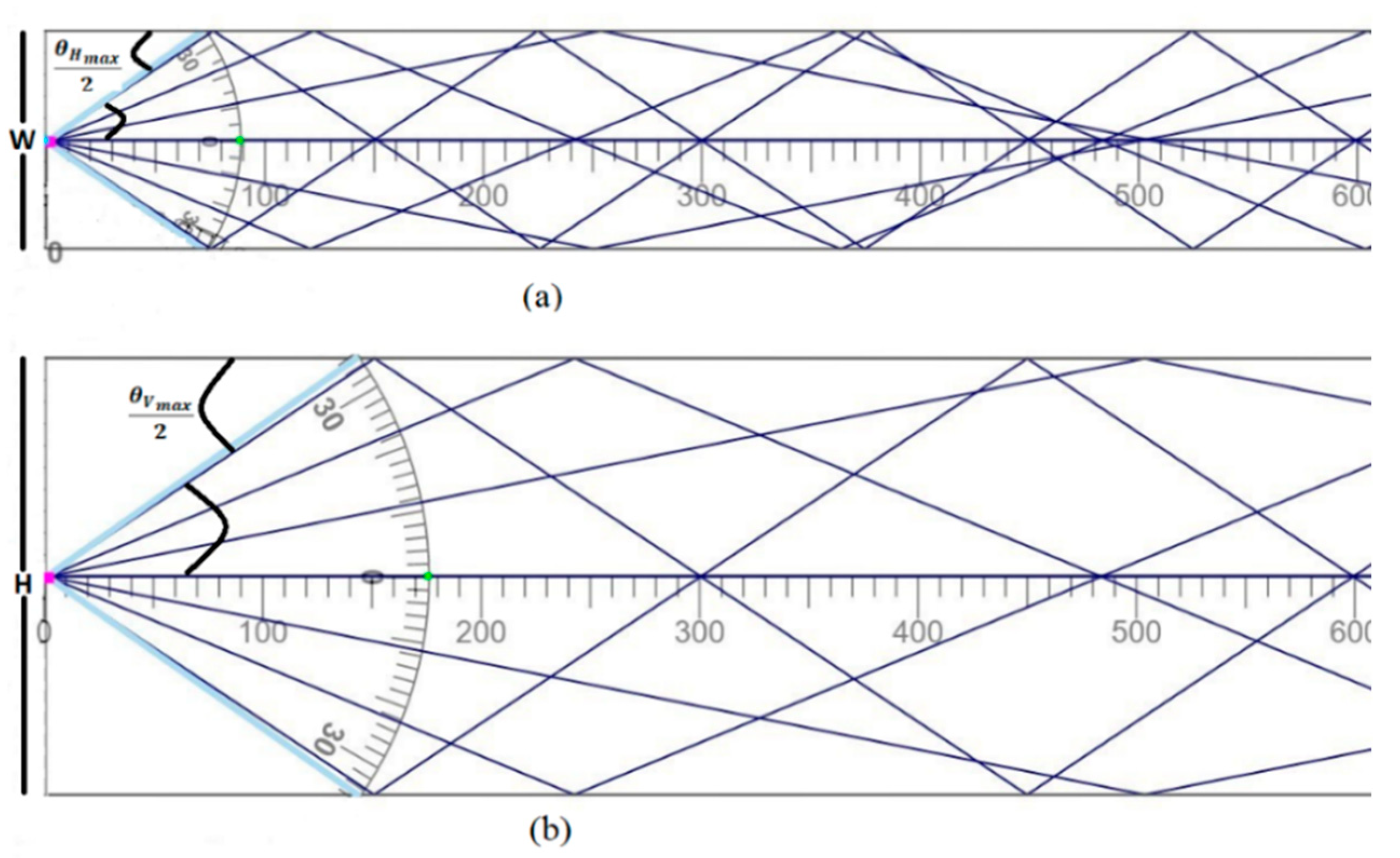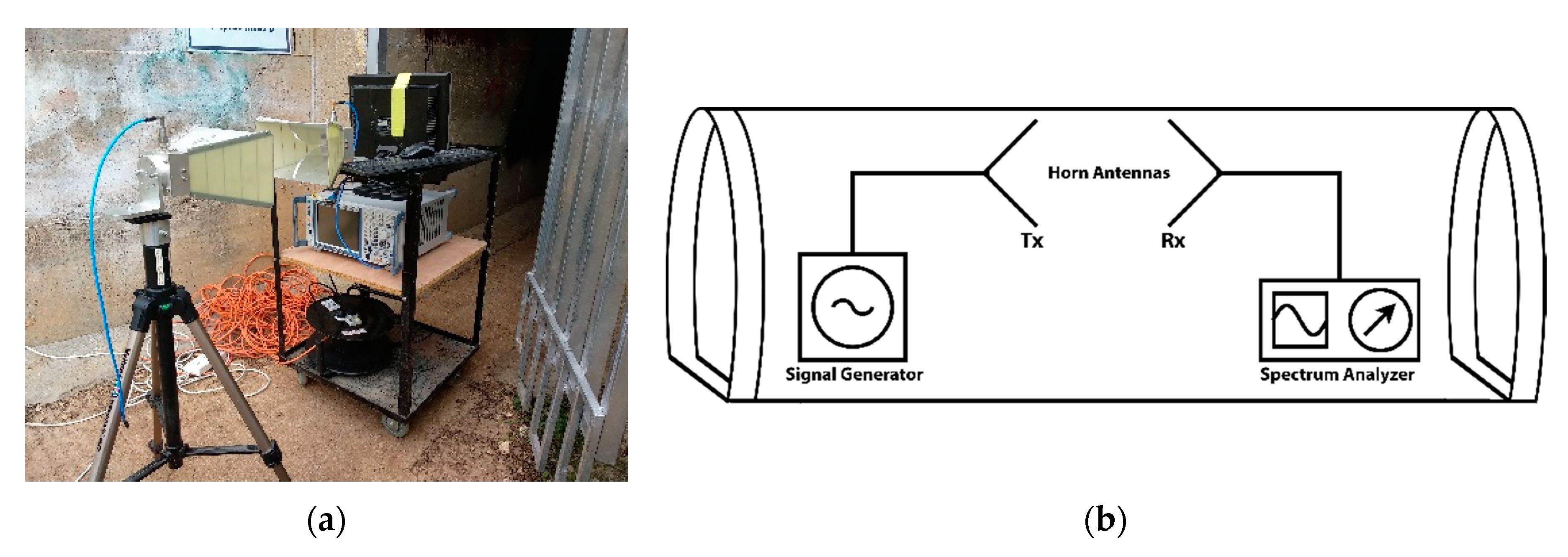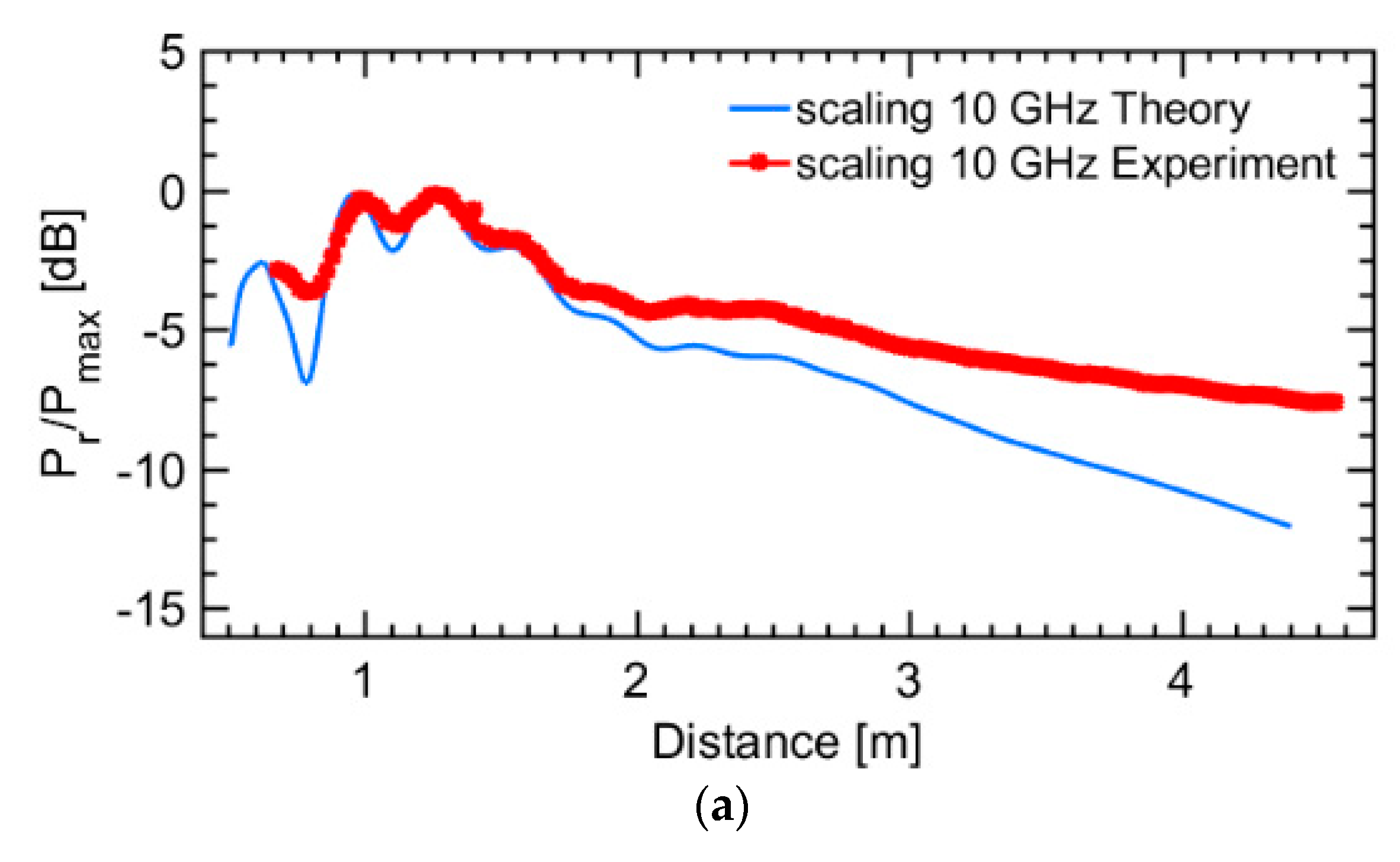Scaled Modeling and Measurement for Studying Radio Wave Propagation in Tunnels
Abstract
1. Introduction
2. Properties of Tunnels and Systems and Their Effect on Propagation
3. Scaling the Ray Tracing Model
4. Experiments in a Rectangular Pedestrian Tunnel
5. Scale Model Experiments in the SHF and the MMWs Regime
6. Conclusions
Author Contributions
Funding
Institutional Review Board Statement
Informed Consent Statement
Data Availability Statement
Conflicts of Interest
References
- Forooshani, A.E.; Bashir, S.; Michelson, D.G.; Noghanian, S. A survey of wireless communications and propagation modeling in underground mines. IEEE Commun. Surv. Tutor. 2013, 15, 1524–1545. [Google Scholar] [CrossRef]
- Yarkan, S.; Güzelgöz, S.; Arslan, H.; Murphy, R. Underground mine communications: A survey. IEEE Commun. Surv. Tutor. 2009, 11, 125–142. [Google Scholar] [CrossRef]
- Hrovat, A.; Kandus, G.; Javornik, T. A Survey of radio propagation modeling for tunnels. IEEE Commun. Surv. Tutor. 2014, 16, 658–669. [Google Scholar] [CrossRef]
- Zhou, C.; Plass, T.; Jacksha, R.; Waynert, J.A. RF Propagation in Mines and Tunnels. IEEE Antennas Propag. Mag. 2015, 57, 88–102. [Google Scholar] [CrossRef]
- Jacard, B.; Maldonado, O. Microwave Modeling of Rectangular Tunnels. IEEE Trans. Microw. Theory Tech. 1984, 32, 576–581. [Google Scholar] [CrossRef]
- Yamaguchi, Y.; Abe, T.; Sekiguchi, T. Radio Wave Propagation Loss in the VHF to Microwave Region Due to Vehicles in Tunnels. IEEE Trans. Electromagn. Compat. 1989, 31, 87–91. [Google Scholar] [CrossRef]
- Lee, J.; Bertoni, H.L. Coupling at cross, T, and L junctions in tunnels and urban street canyons. IEEE Trans. Antennas Propag. 2003, 51, 926–935. [Google Scholar] [CrossRef]
- Li, F.; Han, P.; Wu, X.; Xu, W. Research of UWB signal propagation attenuation model in coal mine. In Lecture Notes in Computer Science (Including Subseries Lecture Notes in Artificial Intelligence and Lecture Notes in Bioinformatics); Springer: Berlin/Heidelberg, Germany, 2007; Volume 4611, pp. 819–828. [Google Scholar] [CrossRef]
- Zhang, Y.P.; Hwang, Y. Enhancement of rectangular tunnel waveguide model. In Proceedings of the Asia-Pacific Microwave Conference, APMC, Hong Kong, China, 2–5 December 1997; Volume 1, pp. 197–200. [Google Scholar] [CrossRef]
- Zhang, Y.P. Novel model for propagation loss prediction in tunnels. IEEE Trans. Veh. Technol. 2003, 52, 1308–1314. [Google Scholar] [CrossRef]
- Wang, T.S.; Yang, C.F. Simulations and measurements of wave propagations in curved road tunnels for signals from GSM base stations. IEEE Trans. Antennas Propag. 2006, 54, 2577–2584. [Google Scholar] [CrossRef]
- Jia, M.; Zheng, G.; Ji, W. A new model for predicting the characteristic of RF propagation in rectangular tunnel. In Proceedings of the 2008 China-Japan Joint Microwave Conference, CJMW, Shanghai, China, 10–12 September 2008; Volume 1, pp. 268–270. [Google Scholar] [CrossRef]
- Didascalou, D.; Schäfer, T.M.; Weinmann, F.; Wiesbeck, W. Ray-density normalization for ray-optical wave propagation modeling in arbitrarily shaped tunnels. IEEE Trans. Antennas Propag. 2000, 48, 1316–1325. [Google Scholar] [CrossRef]
- Rana, M.M.; Mohan, A.S. Segmented-locally-one-dimensional-FDTD method for em propagation inside large complex tunnel environments. IEEE Trans. Magn. 2012, 48, 223–226. [Google Scholar] [CrossRef]
- Bernardi, P.; Caratelli, D.; Cicchetti, R.; Schena, V.; Testa, O. A numerical scheme for the solution of the vector parabolic equation governing the radio wave propagation in straight and curved rectangular tunnels. IEEE Trans. Antennas Propag. 2009, 57, 3249–3257. [Google Scholar] [CrossRef]
- Martelly, R.; Janaswamy, R. An ADI-PE approach for modeling radio transmission loss in tunnels. IEEE Trans. Antennas Propag. 2009, 57, 1759–1770. [Google Scholar] [CrossRef]
- Martelly, R.; Janaswamy, R. Modeling radio transmission loss in curved, branched and rough-walled tunnels with the adi-pe method. IEEE Trans. Antennas Propag. 2010, 58, 2037–2045. [Google Scholar] [CrossRef]
- Carter, R. The Method of Moments in Electromagnetics, by W.C. Gibson. Contemp. Phys. 2010, 51, 183–184. [Google Scholar] [CrossRef]
- Yang, X.; Lu, Y. Research on propagation characteristics of millimeter wave in tunnels. Int. J. Infrared Millim. Waves 2007, 28, 901–909. [Google Scholar] [CrossRef]
- Didascalou, D.; Maurer, J.; Wiesbeck, W. Natural wave propagation in subway tunnels at mobile communications frequencies. IEEE Veh. Technol. Conf. 2000, 3, 2009–2013. [Google Scholar] [CrossRef]
- Didascalou, D.; Maurer, J.; Wiesbeck, W. Subway tunnel guided electromagnetic wave propagation at mobile communications frequencies. IEEE Trans. Antennas Propag. 2001, 49, 1590–1596. [Google Scholar] [CrossRef]
- Sun, Z.; Akyildiz, I.F. Channel modeling and analysis for wireless networks in underground mines and road tunnels. IEEE Trans. Commun. 2010, 58, 1758–1768. [Google Scholar] [CrossRef]
- Molina-Garcia-Pardo, J.M.; Lienard, M.; Stefanut, P.; Degauque, P. Modeling and understanding MIMO propagation in tunnels. J. Commun. 2009, 4, 241–247. [Google Scholar] [CrossRef]
- Wang, S. Radio Wave Attenuation Character in the Confined Environments of Rectangular Mine Tunnel. Mod. Appl. Sci. 2010, 4, 65–70. [Google Scholar] [CrossRef]
- Rissafi, Y.; Talbi, L.; Ghaddar, M. Experimental characterization of an UWB propagation channel in underground mines. IEEE Trans. Antennas Propag. 2012, 60, 240–246. [Google Scholar] [CrossRef]
- Han, X.; Wang, S.; Fang, T.; Guo, Z. Propagation character of electromagnetic wave of the different transmitter position in mine tunnel. In Proceedings of the International Conference on Networks Security, Wireless Communications and Trusted Computing, NSWCTC 2009, Wuhan, China, 25–26 April 2009; Volume 1, pp. 530–533. [Google Scholar] [CrossRef]
- Zhang, Y.P.; Zhang, W.M.; Sheng, J.H.; Zheng, G.X. Radio propagation at 900 MHz in underground coal mines. Meitan Xuebao/J. China Coal Soc. 2002, 27, 83. [Google Scholar] [CrossRef]
- Cheng, L.; Zhang, P. Influence of dimension change on radio wave propagation in rectangular tunnels. In Proceedings of the 5th International Conference on Wireless Communications, Networking and Mobile Computing, WiCOM 2009, Beijing, China, 24–26 September 2009; pp. 9–11. [Google Scholar] [CrossRef]
- Hemalatha, A.B.R.; Savithri, T.S. Development of an Optimized Ray Tracing Path Loss Model in the Indoor Environment. Wirel. Pers. Commun. 2017, 96, 1039–1064. [Google Scholar] [CrossRef]
- Yao, S.H.; Wu, X.L. Electromagnetic waves multi-path model based on image approach in tunnels. In Proceedings of the 2011 International Conference on Electric Information and Control Engineering, ICEICE 2011, Wuhan, China, 15–17 April 2011; pp. 2150–2153. [Google Scholar] [CrossRef]
- Rapaport, L.; Pinhasi, G.A.; Pinhasi, Y. Millimeter Wave Propagation in Long Corridors and Tunnels—Theoretical Model and Experimental Verification. Electronics 2020, 9, 707. [Google Scholar] [CrossRef]
- Rappaport, T.S. Wireless Communications Principles and Practice, 2nd ed.; Prentice Hall: Upper Saddle River, NJ, USA, 2002. [Google Scholar]
- Available online: https://ricktu288.github.io/ray-optics/ (accessed on 1 January 2020).
- Olkkonen, M.; Mikhnev, V. Complex Permittivity of Concrete in the Frequency. In Proceedings of the 2013 7th European Conference on Antennas and Propagation (EuCAP), Gothenburg, Sweden, 8–12 April 2013; pp. 3319–3321. [Google Scholar]










| Band | UHF Real Tunnel | UHF Real Tunnel | SHF Real Tunnel and Scaling for 1 GHz | W-Band Scaling for 10 GHz |
|---|---|---|---|---|
| Frequency (GHz) | 1 | 2.4 | 10 | 94 |
| Wavelength (cm) | 29.98 | 12.49 | 2.998 | 3.19 |
| 3.335 | 8.006 | 33.35 | 313.5 | |
| 6.17 | 14.81 | 61.7 | 579.9 |
| Band | UHFReal Tunnel | SHF Scaling for 1 GHz | SHF Real Tunnel | W-Band Scaling for 10 GHz |
|---|---|---|---|---|
| Frequency (GHz) | 1 | 10 | 10 | 94 |
| Wavelength (cm) | ||||
| Width (m) | ||||
| Height (m) | ||||
| Antenna Aperture (deg) | ||||
| Horn Antenna | Frequency (GHz) | Gain (dBi) | H-Plane 3 dB Beamwidth (deg) | E-Plane 3 dB Beamwidth (deg) |
|---|---|---|---|---|
| A-INFO | 1 | 4.97 | 71 | 70 |
| X-Band Gray | 10 | 15.7 | 33 | 30.6 |
| X-Band Black | 10 | 10.8 | 61.2 | 47.7 |
| A-INFO | 10 | 12.69 | 35 | 33.4 |
| W-Band | 94 | 24 | 8.8 | 8.2 |
Publisher’s Note: MDPI stays neutral with regard to jurisdictional claims in published maps and institutional affiliations. |
© 2020 by the authors. Licensee MDPI, Basel, Switzerland. This article is an open access article distributed under the terms and conditions of the Creative Commons Attribution (CC BY) license (http://creativecommons.org/licenses/by/4.0/).
Share and Cite
Gerasimov, J.; Balal, N.; Liokumovitch, E.; Richter, Y.; Gerasimov, M.; Bamani, E.; Pinhasi, G.A.; Pinhasi, Y. Scaled Modeling and Measurement for Studying Radio Wave Propagation in Tunnels. Electronics 2021, 10, 53. https://doi.org/10.3390/electronics10010053
Gerasimov J, Balal N, Liokumovitch E, Richter Y, Gerasimov M, Bamani E, Pinhasi GA, Pinhasi Y. Scaled Modeling and Measurement for Studying Radio Wave Propagation in Tunnels. Electronics. 2021; 10(1):53. https://doi.org/10.3390/electronics10010053
Chicago/Turabian StyleGerasimov, Jacob, Nezah Balal, Egor Liokumovitch, Yair Richter, Michael Gerasimov, Eran Bamani, Gad A. Pinhasi, and Yosef Pinhasi. 2021. "Scaled Modeling and Measurement for Studying Radio Wave Propagation in Tunnels" Electronics 10, no. 1: 53. https://doi.org/10.3390/electronics10010053
APA StyleGerasimov, J., Balal, N., Liokumovitch, E., Richter, Y., Gerasimov, M., Bamani, E., Pinhasi, G. A., & Pinhasi, Y. (2021). Scaled Modeling and Measurement for Studying Radio Wave Propagation in Tunnels. Electronics, 10(1), 53. https://doi.org/10.3390/electronics10010053








